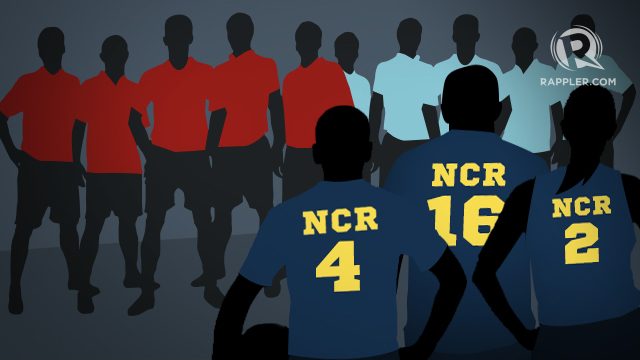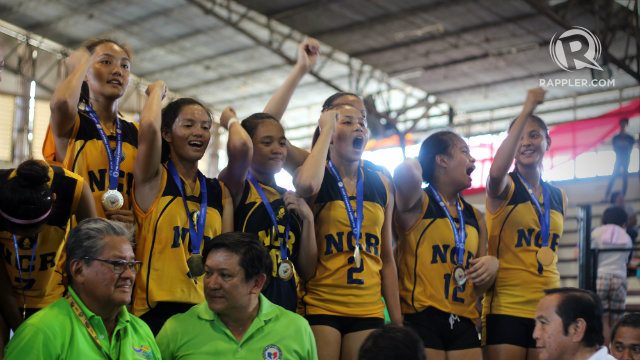SUMMARY
This is AI generated summarization, which may have errors. For context, always refer to the full article.

TAGUM CITY, Philippines – Even winners must lose at some point.
And that’s exactly what the Davao Region (Region XI) is hoping to achieve, hopefully in the near future, against long-time champions National Capital Region (NCR) at Palarong Pambansa, the country’s largest multi-sporting event.
But how do you take down a perennial champion that produces highly competitive athletes thanks to its enormous pool of resources?
“It will require continuing reforms,” Davao del Norte Governor Rodolfo del Rosario shared his insights to Rappler one dry afternoon in Tagum City, the host of this year’s Palaro.
Del Rosario explained how the private schools of Manila are always a step ahead, even against the private schools of provinces.
“Itong Palarong Pambansa, it just occured to me, akala ko strictly public schools. Ngayon pala pati private schools kasama rito,” he said. (Palarong Pambansa, it just occured to me, is not strictly for public schools. Now we have private schools participating already.)
“And who has the best private schools in the country? Hindi ba nasa NCR (Is it not NCR)? Ateneo, La Salle, UP, Mapua, UST. They’re participating in the games.
“Here in the provinces, we have private schools here but we don’t have the kinds of private schools they have there. They really tap their athletes and scout. Before you know it they’re already in the private schools with scholarships.”
NCR has been Palaro’s champions in the last decade. They have not relinquished their hold of overall champion of the games since 2005. And 2015 is no different as NCR emerged triumphant with 98 gold, 67 silver and 71 bronze medals.
Calabarzon was once again a far second with a 51-41-49 medal haul, while Western Visayas came in at third with 42-48-41.
Usurping the region where the country’s capital is located has been close to impossible with NCR clobbering its competition by an average of 106.3 medals since 2012.
Last year, while the disparity in total medal count was significantly lower than previous years – as it decreased to 87 in 2014 from 110 in 2013 and 122 in 2012 – NCR still proved its dominance with its gold medal haul. They ran away with the overall championship with 107 golds as opposed to just 38 and 32 by podium finishers Calabarzon and Western Visayas, respectively.
Over the last decade, the remaining two slots at the podium was contested between Western Visayas and Calabarzon, though Central Visayas and Northern Mindanao ousted Calabarzon for third place in 2013 by virtue of point system and medal tally, respectively. Palaro determines the overall champion either by point system or medal tally and it varies each year.
Del Rosario’s Davao region, which finished 8th last year, slipped to 9th place this year despite “homecourt” advantage with 13 golds, 23 silvers and 30 bronzes.
Athlete piracy
Most coaches, media and watchers attribute NCR’s dominance to athlete “piracy” – something they say is made possible by the region’s wealthy resources.
“Sabi nga namin, kung hindi lang gagawin ng NCR yung pamimirata ng athletes mas malakas kami. Totoo yan,” said Pacita Lungcay, Education Program Supervisor for the Department of Education in Calabarzon, who did not drop any athlete names. “Kasi katulad last year yung ilang kalaban namin sa swimming ay mga athletes namin before na na-pirate ng NCR.”
(We always say that if only NCR did not pirate athletes, we’re stronger. It’s true. Like last year some of the athletes we competed against in swimming were those pirated by NCR.)
Recruiting athletes from provinces has long been convention in Philippine sports. For instance, scouts from Manila make the effort to attend the Palaro, among other local sporting events, to search for outstanding athletes whom they offer scholarships and, in some cases, alleged additional perks and allowances.
The lure of a full ride to college along with many other opportunities is hard to ignore for most young athletes who hail from impoverished to average backgrounds. They simply want a chance for a better life, and if it’s something these scouts from NCR can provide them, they can’t be blamed for jumping ship.
Veteran journalists who have covered Palarong Pambansa for years affirm recruitment is a significant factor that contributes to the continued competitive gap between NCR and the rest of the regions.
“Ngayon, ang palagi namin sinasabi is we will play as a team. Solid tayo (Now, we just tell ourselves that we will play as a team. We’re a solid unit),” said Lungcay.
Del Rosario himself regressed and admitted NCR is too huge a force to reckon with.
“We cannot compete with the people in Manila because they have a lot of resources. Hindi naman pwede swelduhan yung mga athletes namin (We can’t give salaries to our athletes).”
Del Rosario, however, also presents a different yet important perspective when it comes to the so-called athlete piracy.
“Ganoon din naman yun (It’s the same), if they end up in private schools then the better,” he said, adding that this practice does not make beating NCR a hopeless dream.
“That’s an opportunity for them (athletes) and they will build up their abilities. Pag nagkaroon ng Palaro and makitang magaling ka, ma-tap ka nila (If there is a Palaro and they see you’re good, and they tap you), they will give you all the benefits you want. It’s an advantage and it’s a good thing to happen.”

Promoting parity
With NCR expected to win year in and year out as if by default, parity is practically extinguished at Palarong Pambansa. Like a giant without a weakness fighting against much smaller foes, nobody has yet to upset the accustomed dominance of NCR. But Calabarzon is not giving up.
“Of course lahat naman ang target is makuha yung overall champion, kaya lang yung case sa halos lahat ng regions, parang hindi siya talaga ganoon kadali,” said Lungcay. “Pero ginagawa naman namin lahat ng magagawa namin para at least makahabol kami.”
(Of course everyone’s goal is to become overall champion, but in the cases of the regions, it’s never easy. But we are doing everything we can to match up.)
The Department of Education (DepEd), the organizer of the annual games, recognizes the need for parity among regions, which led to putting in place a point system two years ago on top of the regular medal system.
The point system aims to put more value on every medal earned and give other regions a shot at earning a podium finish even if they don’t garner the most golds.
This year’s Palaro overall champion, however, was determined by medal tally. And even if a region who makes more points off of silver medals than another region that wins a few golds, the fact remains that NCR still tops everybody else with its high volume of golds medals.
Some of the media assess that NCR’s supremacy is, in large part, a result of their competitiveness in medal-rich sports, which is the key to winning multi-sporting events. Such sports include swimming, athletics and gymnastics. This year, NCR collected 32 of its 98 total golds from swimming.
In addition to the point system, DepEd Assistant Secretary Tonisito Umali shared plans for a program called “One Child, One Sport,” which aims to ensure each child can play and is knowledgeable of at least one sport.
“Sa pakikipagugnayan ng LGU, hihikayatin natin na ang bawat bata ay makakapaglaro at magiging mahusay sa iisang palakasan lang,” Umali said in a press briefing at the games. “Pag sinabing One Child, One Sport, hilig niya ito. Alam niya yung storya ng sport.”
(In coordination with the LGU, we will encourage every child to play and become well-versed in one sport. When we say One Child, One sport, we mean the child truly loves one sport. He or she knows the history of that sport.)
That is in addition to including sports as one of the tracks in the K to 12 curriculum.
“We believe that a child with at least one sport in his mind will go a great way, not only in being a better person in terms of physical health, but also in terms of discipline etc.,” Umali added.
Meanwhile, some regions are taking matters into their own hands.
No longer wanting to remain a perennial bridesmaid, Calabarzon hopes its efforts to provide its homegrown athletes with sufficient training facilities as well as international exposure will yield Palaro rewards.
For next year, Calabarzon plans on putting more emphasis and focus on some of their weaker sports such as boxing and archery.
“Siguro may mga events pa kami na kailangan pa namin matutukan,” Lungcay said when asked what the region should do for a better showing next year. “Yun yung mga events na hindi nakakatulong sa amin na umangat.” (There are still some events that we need to focus and improve on. Those events that are not helping us rise up.)
Aside from Calabarzon, the Davao region is also gearing up for a competitive future with its grassroots sports development program, which involves developing swimmers out of children living in coastal areas and runners out of children living in the highlands. (WATCH: Floating pool future of PH swimming)
The lack of parity at Palaro reflects the Philippines’ economical and societal status, where people flock to the capital in the hope of capitalizing on supposedly better opportunities. If there were equal opportunities across all regions, most would not feel the need to relocate and abandon their natural way of life.
The same parity is required in producing competitive athletes to represent the country internationally. Ideally, grassroots programs should be standard, instead of a once in a blue moon occurence. Equal opportunities can yield the best athletes from every part of the Philippines, while monopolizing limits what the nation can achieve in sports.
At Palaro, NCR and its resources remain too much to overcome, for now. But if other regions institutionalize a stable system for sports development, change will come soon enough. – with reports from Michael Jugado/Rappler.com
Add a comment
How does this make you feel?
There are no comments yet. Add your comment to start the conversation.